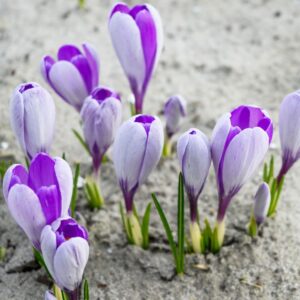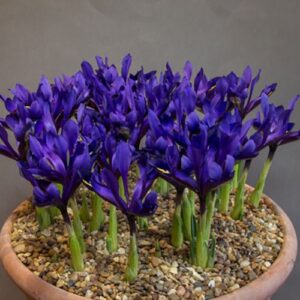I think I can say that this year has been the most difficult gardening year I’ve ever known. And I’ve known a lot! Temperatures fell a full ten degrees at the beginning of the year, following an exceptionally mild spell and lots of plants were caught out and subsequently perished. Penstemons and echinaceas were my main casualties here, but I also lost a lovely mallow-like plant named Anisodonta ‘El Rayo’. The pink, hibiscus-like flowers appear for many months. I’ve planted another, so fingers crossed.
Losses were due to the sudden sharp drop in temperatures, because it caught plants unawares. Plants produce their own version of antifreeze, but the process is only prompted by colder weather. Spring was cold here and it was followed by two scorching weeks in June. I began to line up the watering cans, expecting another hot, dry summer like last year. However, the weather gods had other ideas. By July we had never-ending rain, dull skies and cool weather and August was almost as bad here.
My summer clothes didn’t get that much of an airing and it seemed to dish up the worst weather at the weekends. At the moment we’re experiencing a warm autumn with temperatures approaching 20C. This year I’m being wise and taking penstemon cuttings. I’m also praying that winter makes an appearance by November so that my plants have time to produce their antifreeze.
The worst thing about this year, was being without my greenhouse for six months. My old wooden one gave up the ghost last spring and my new Hartley didn’t arrive until September. I use my greenhouse all the time, so I really missed it. I normally keep terracotta pots of bulbs containing small narcissi, crocus and muscari undercover in summer, for instance. This allows them to dry off and then they can be repotted in early autumn. This year I was forced to place them against a wall and, when I came to repot them up again, many of the pots were empty. The wet summer had made them rot off.
Every autumn I pot up crocuses, muscari and miniature narcissi and keep them in the greenhouse. They get watered once, straight after planting, and then they get left alone until the compost dries out. The finger test is the best way to see if the compost is dry, because different peat-frees behave in different ways. Wool composts, such as Dalefoot, hold water at the bottom of the pot, so poke about. They also stay darker in colour. Wood-based compost get a fluffy grey-brown layer on the surface, but may be wet underneath. My current peat-free go to comes from Dobbies Garden Centres.

This year I’ve experimented with some new crocuses from Rose Cottage Plants, a really good supplier of bulbs and dahlias. It’s worth mentioning that smaller-flowered crocuses are the first to flower and they will often flower by late January under glass. In the garden setting, it’s normally February here. These smaller corms prefer drier conditions, so don’t overwater them. Crocus ‘Ladykiller’ is a white with bold purple markings. ‘Cream Beauty’ is a custard-cream shade of yellow. It’s worth growing them in pots, because smaller crocuses tend to fade away in the garden.

Dutch crocuses, which have larger corms, are derived from an alpine meadow species named Crocus vernus. They make large clumps in time and they can be grown in grass. They flower in the garden in March, a full four weeks later than the smaller-flowered ones. I have planted a potful of ‘Whale Shark’, definitely a name thought up by a man, I think. It’s a silvery grey and purple crocus and rather like another named ‘Yalta’. ‘Yalta’ is not widely available this year and ‘Vanguard’, also a purple and silver, is in short supply. ‘Vanguard’ is my desert-island crocus, because this Russian-collected crocus if precocious and flowers two weeks before most other Dutch crocuses.
Growing something new in pot, under glass, is beneficial in many ways. It’s possible to bulk up the bulbs more efficiently. It allows you to assess the value and beauty of each ‘newby’ and it gives you earlier flowers that lift winter gloom. These can be placed outside on a plant theatre as they come into flower. It also allows crocus corms to survive the ravages of rodents and squirrels. I seem to have the fattest squirrels ever this year, although voles are the worst when it comes to feasting on crocus corms. They eat the corms at every stage, leaving a trial of foliage and leaf behind.

Muscaris, known as grape hyacinths, also make good pot specimens and they’re not all invasive spreaders like M. armeniacum. They are also very bee-friendly and the spike of flowers lasts longer than most other bulbs. M. azureum is the prettiest with paler Cambridge-blue flowers below a tight, greenish cone of buds. It will spread in the garden though. ‘Julia’ is a new one with more pale-green at the top. I also like a fuzzy double bluebell-blue coloured one, ‘Fantasy Creation’ but only when it’s grown in pots.
Anemone blanda is another great pot plant, but this open-rayed sun-loving daisy shouldn’t be confused with the nodding flowers of the woodlander A. nemorosa. Blue Anemone blanda, which has raisin-like tubers, self-seeds in my garden. If love it in a large containers, grown underneath a swirling orange brown sedge named Carex testacea.
Blue anemones also mingle well with miniature daffodils and they’re just the right height for simple terracotta pots roughly six to eight inches in height. ‘Rip van Winkle’ is a ragged double with narrow yellow petals backwashed in a green. It flops in the garden setting, gathering mud, but it’s fabulous drooping over a wider terracotta pot.
Larger pots of taller narcissi are best started off outside and my favourite is the scented, multi-headed ‘Golden Echo’. The pale-yellow outers frame a richer yellow trumpet and the two colours overlap and fuse together, so this isn’t brash.
If you’re a cut-flower person there are many new florist’s anemones including a new Mistral series of bright colours with dark-black middles. Double ranuculas are also on offer and they make good pot specimens and cutting plants for the border. Both are slightly too tall for smaller pots though. Explore Farmer Gracy UK for ideas.

The great thing about all these miniature bulbs, is they won’t break the bank. Miniature irises are also good value and choicer varieties, such as the smoke-blue and yellow ‘Katherine Hodgkin’ and its all-yellow seedling ‘Katherine’s Gold’, are both far easier to keep going in pots than they are in the ground. ‘Katherine’s Gold’ is more enduring of the two in my garden.
Both are said to be hybrids between the impossible (for me anyway) to keep Iris winogradowii and I. histrioides, although this is shrouded in mystery. ‘Katherine Hodgkin’ was raised by a famous gardener named EB Anderson. He recorded (in Seven Gardens or Sixty Years of Gardening published in 1962) it as a hybrid between I. histrioides ‘Major’ and a Turkish yellow snow-melt miniature named I. danfordiae. The latter is notoriously difficult to grow in British gardens, because the bulbs fragment into tiny divisions, so this one needs replanting annually.
The commercially available form of I. danfordiae is triploid, so the yellow flowers bear little or no viable pollen. Perhaps Anderson has a wild-collected form with pollen. The lack of pollen in the commercially grown I. danfordiae has hampered attempts to breed more yellow-flowered miniature irises.
There are two other similar grey-blue hybrids named ‘Frank Elder’ and ‘Sheila Ann Germaney’. They too, tend to disappear in the garden. ‘Katherine Hodgkin’ is the most vigorous grower of the three. The nurseryman John Amand acquired six bulbs from the late Kath Dryden in the early 1980s and took them to Holland. There are now acres of them in production, all emanating from those six original bulbs.
The most enduring miniature iris is ‘Lady Beatrix Stanley’, a bright blue with white spotting and a slender yellow beard. This has been grown since 1930 and Lady B, who went plant hunting with Edward Augustus Bowles, may have collected it in the wild. The secret of Lady B’s endurance lies in producing long leaves about fifteen inches in length. These can prove tedious in summer! The snowdrop named after her is also divine.
Hybrids always have more vigour and those involving another miniature iris, Iris reticulata, are no exception. ‘George’ is a rich, plum-purple. From 1973. The royal blue ‘Harmony’ and the violet-blue ‘Pixie’ both got AGMs on a recent RHS trial held at Hyde Hall in Essex. They RHS panel also trialled the McMurtie irises bred in Canada. These have proved problematic for me, because the flowers aren’t very weather resistant. They also flower too early, often over the New Year. They were not given AGMs. However, they thrive at Hyde Hall, due to a drier climate perhaps. ‘Eyecatcher’ has proved the most enduring. White petals are dappled in blue and yellow. I covet one called ‘Storm’, a mixture of moody purples and greys.











